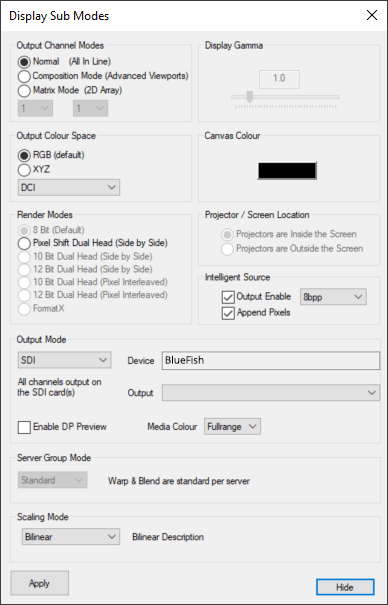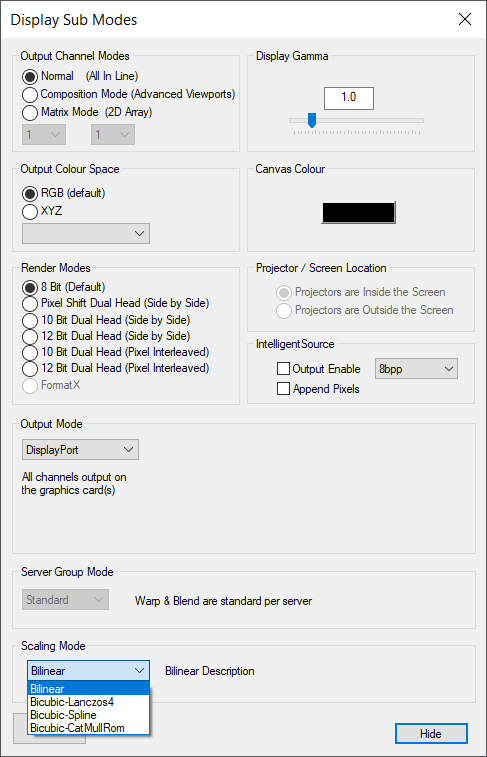![]() Output setup allows configuration of channel locations in the playback window, overall gamma, and which physical outputs are active. Note that the setup here should match that set in any graphics card setup on the server.
Output setup allows configuration of channel locations in the playback window, overall gamma, and which physical outputs are active. Note that the setup here should match that set in any graphics card setup on the server.
Press the Output Setup button to show the output mode dialog:

Output Channel Modes
If Normal, channels are arranged in a horizontal line on the desktop.
If Composition Mode, output channels are directly editable in XYWH on the output framebuffer.
If Matrix Mode, channels can be arranged in a X by Y grid on the playback window.
Output Colour Space
RGB is the normal colour space, but some projectors, typically in Digital Cinema, take an XYZ colour space. The dropdown list contains various RGB-XYZ mappings:
•DCI and CIE are fixed, internal mappings.
•Same is a 1:1 RGB-XYZ (no change) mapping for testing.
•DCI_File is stored in System / ColourSpaceConvert.xml file and can be changed.
Render Modes
This choice relates to the way colour data is packed and how particular projectors interpret that data. It does not enable bit-depth colour and does not apply to SDI output mode. In most cases this should be left at 8-bit.
High bit-depth colour is an optional licence. For working with 10-bit colour depth, please see this section in our Display Configuration guide. |
Current high bit depth capabilities for Delta are:
Connector type |
High bit depth |
|---|---|
SDI |
Up to 12 bit |
HDMI 1.4 |
Up to 10 bit |
HDMI 2.0 |
Up to 12 bit |
DisplayPort |
Up to 12 bit |
DVI |
(Older servers) 8 bit only from single cable. Special packing formats for Dual cable or Dual DVI (including JVC 12 bit and others) are also available. [Please contact us for more information.] |
Rivermax™ |
Any |
Note: Wobulation techniques for JVC are also natively supported. |
Norxe Wobulator Projectors
When using a Norxe Wobulation projector, the user may want to duplicate the output from Delta, but shift this duplicate by 0.5 pixels in height and width.
With Delta 2.7 build 6, a Pixel shift render mode was added in Display > Output Setup.
This shift of half a pixel can also have an interleave value set meaning that the first output from Delta is providing all the ‘even’ vertical pixels and the second (duplicate) is providing all the ‘odd’ pixels. These feeds both go into the projector and are overlaid on top of each other to create the image. You can then enable wobulation on the projector, which takes advantage of the half-pixel shift in the x/y axis. The pixel shift values can also be minus values if the wobulation is in a negative axis. This will require adjustment to some registry settings.
Default Pixel shift properties in the Windows registry can be found in \HKEY_LOCAL_MACHINE\SOFTWARE\7thSense\Delta\Graphics:
Key |
Default |
Function |
|---|---|---|
PixelShiftHorizontal |
0.5 |
If pixel shift is being used, sets the shifting amount of pixels horizontally |
PixelShiftHorizontalInterleaveOn |
1 |
If pixel shift is being used, sets the flag to interleave pixels horizontally |
PixelShiftVertical |
0.5 |
If pixel shift is being used, sets the shifting amount of pixels vertically |
PixelShiftVerticalInterleaveOn |
0 |
If pixel shift is being used, sets the flag to interleave pixels vertically |
Registry Edits |
7thSense software uses the Windows Registry extensively, and on occasion we make recommendations for changes. •Before making any changes, close DeltaGUI and DeltaServer. •DeltaServer can take up to 10 seconds to fully close in the background, even if it appears that all the Windows have closed. Ensure that Delta has fully closed before opening and/or refreshing, and finally editing. The best way to ensure this, is to watch Windows Task Manager > Details list. You will see ‘DeltaServer.exe’ in this list if DeltaServer is still running. If it won’t close for any reason, you can right click on it in the list and choose ‘End Process Tree’. •Make a note of any setting before you change it, in case you want to change it back. •Only make the changes as recommended and only to those registry keys. |
Projector / Screen Location (Dome Mode required)
For Dome (Frustum) and Mesh Modes, the standard configuration is to have projectors inside a dome screen.
For those systems where the projectors are projecting onto the outside of the dome screen, choose the ‘Projectors are Outside the Screen’ option. You must then place the channels (virtual projectors) outside and pointing at the screen. Intelligent resources in this mode will also automatically horizontally mirror visual resources so that text still reads correctly.
IntelligentSource™
Check ‘Output Enable’ if you are require IntelligentSource frame data in your output. Select the format for the IntelligentSource data row to match that of the receiving decoder. By default Delta will sacrifice pixels of the first row of each frame. Alternatively you can choose to append a row at the top of each frame to contain the IS data and employ an EDID adjusted for this.
➢See also IntelligentSource™
➢Composition Mode and IntelligentSource
Display Gamma
This slider controls the overall display gamma on the server PC – this value is saved in the file.
Canvas Colour
This is the background colour which shows when there are no visual resources on the timeline.
Output Mode (Optional Licences)
Select from DisplayPort (default), SDI, VR or ST2110 modes to match the server configuration
•DisplayPort mode outputs on the server’s graphics card.
•SDI mode outputs on SDI output cards (BlueFish, Matrox, if present).
•VR Headset (unavailable in Flatplane Mode) outputs on HDMI to the VR headset, with optional DisplayPort preview (extra load) of the VR view. This requires mesh mode and stereo licences.
•ST 2110 enabled by licence for servers with Mellanox Rivermax™ network adapters.
Note: The optional DisplayPort preview adds extra load to the canvas for modes other than DisplayPort.
➢See Appendix C for more SDI details.
Server Group Mode (Optional Licence)
This mode is for when multiple servers drive a single 4K projector (if required) and allows the user to designate which half or quadrant this server is responsible for – when adjusting warp and blending, the same information is used in all servers to maintain coherent geometry across all servers. Since a single Delta server can drive multiple 4K projectors, this option is for high-end testing only.
Scaling Mode
From Delta 2.7 build 6, this additional control allows for choice of scaling mode, bilinear, Lanczos or bicubic. Scaling mode is accessible via external control.
Page edited [d/m/y]: 01/09/2022
